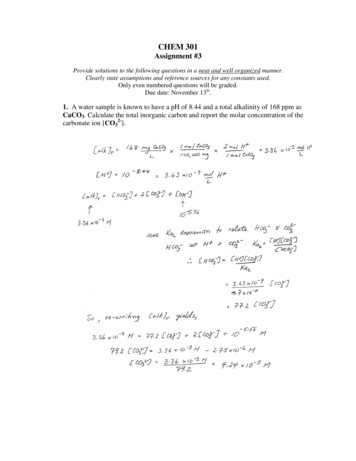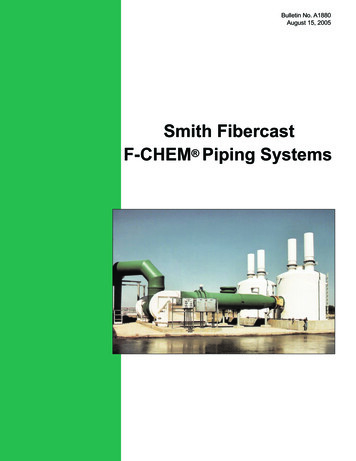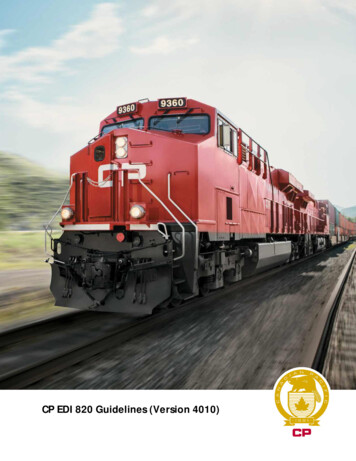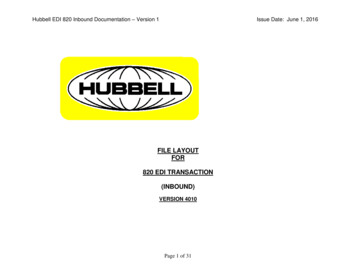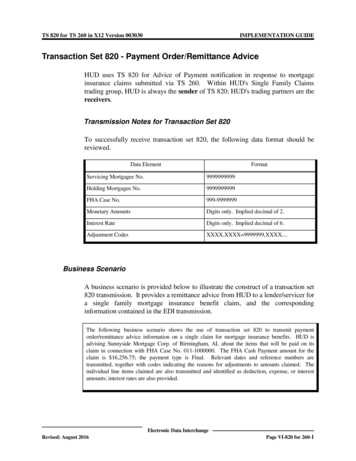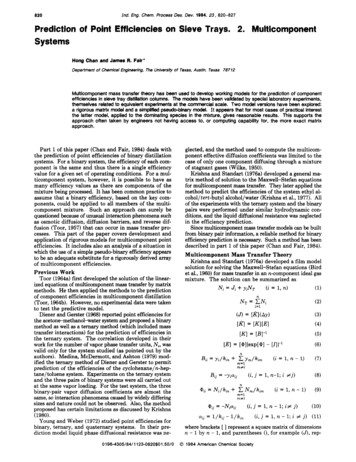
Transcription
820Ind. Eng. Chem. Process Des. Dev. 1984, 23,820-827Prediction of Point Efficiencies on Sieve Trays. 2. MulticomponentSystemsHong Chan and James R. Fair'Department of Chemical Engineering, The University of Texas, Austin, Texas 78712Multicomponent mass transfer theory has been used to develop working models for the predictton of componentefficiencies in sieve tray distillation columns. The models have been valiited by special laboratory experiments,themselves related to equlvalent experiments at the commercial scale. Two model versions have been explored:a rigorous matrix model and a simplified psewbbhmry model. I t appears that for most cases of practical interestthe latter model, applied to the dominating species in the mixture, gives reasonable results. This supports theapproach often taken by engineers not having access to, or computing capability for, the more exact matrixapproach.Part 1 of this paper (Chan and Fair, 1984) deals withthe prediction of point efficiencies of binary distillationsystems. For a binary system, the efficiency of each component is the same and thus there is a single efficiencyvalue for a given set of operating conditions. For a multicomponent system, however, it is possible to have asmany efficiency values as there are components of themixture being processed. It has been common practice toassume that a binary efficiency, based on the key components, could be applied to all members of the multicomponent mixture. Such an approach can surely bequestioned because of unusual interaction phenomena suchas osmotic diffusion, diffusion barriers, and reverse diffusion (Toor, 1957) that can occur in mass transfer processes. This part of the paper covers development andapplication of rigorous models for multicomponent pointefficiencies. It includes also an analysis of a situation inwhich the use of a simple pseudo-binary efficiency appearsto be an adequate substitute for a rigorously derived arrayof multicomponent efficiencies.Previous WorkToor (1964a) first developed the solution of the Iinearized equations of multicomponent mass transfer by matrixmethods. He then applied the methods to the predictionof component efficiencies in multicomponent distillation(Toor, 1964b). However, no experimental data were takento test the predictive model.Diener and Gerster (1968)reported point efficiencies forthe acetonemethanol-water system and proposed a binarymethod as well as a ternary method (which included masstransfer interactions) for the prediction of efficiencies inthe ternary system. The correlation developed in theirwork for the number of vapor phase transfer units, N,, wasvalid only for the system studied (as pointed out by theauthors). Medina, McDermott, and Ashton (1979) modified the ternary method of Diener and Gerster to permitprediction of the efficiencies of the cyclohexaneln-heptane/toluene system. Experiments on the ternary systemand the three pairs of binary systems were all carried outat the same vapor loading. For the test system, the threebinary-pair vapor diffusion coefficients are almost thesame, so interaction phenomena caused by widely differingsizes and nature could not be observed. Also, the methodproposed has certain limitations as discussed by Krishna(1980).Young and Weber (1972) studied point efficiencies forbinary, ternary, and quaternary systems. In their prediction model liquid phase diffusional resistance was ne0196-4305/84/1123-0820 01.50/0glected, and the .method used to compute the multicomponent effective diffusion coefficients was limited to thecase of only one component diffusing through a mixtureof stagnant gases (Wilke, 1950).Krishna and Standart (1976a) developed a general matrix method of solution to the Maxwell-Stefan equationsfor multicomponent mass transfer. They later applied themethod to predict the efficiencies of the system ethyl alcoholltert-butyl alcohol/water (Krishna et al., 1977). Allof the experiments with the ternary system and the binarypairs were performed under similar hydrodynamic conditions, and the liquid diffusional resistance was neglectedin the efficiency prediction.Since multicomponentmass transfer models can be builtfrom binary pair information, a reliable method for binaryefficiency prediction is necessary. Such a method has beendescribed in part 1 of this paper (Chan and Fair, 1984).Multicomponent Mass Transfer TheoryKrishna and Standart (1976a) developed a film modelsolution for solving the Maxwell-Stefan equations (Birdet al., 1960) for mass transfer in an n-component ideal gasmixture. The solution can be summarized as YiN,Ni J i(i 1, n)(1)nNT CNi(2)i l(4 [kl(Ay)(3)[m [KI[El(4)[K] [B]-'(5)[El [@I{exp[@l- [111-1(6)nBii yi/kin mc lYm/kim(i 1, n-1)(7)m#i(i, j 1, n-1; i # j )B LJ, . -yiaij*Ii Ni/kin11 (8)n"/ki,(i 1, n - 1)(9)m lm#i -Niaij(i, j 1, n - 1; i# j )aij l / k i j - l / k i n(i, j 1, n - 1;i(10)# j ) (11)where brackets [ 3 represent a square matrix of dimensionsn - 1 by n - 1, and parentheses 0, for example (J),rep0 1984 American Chemical Society
Ind. Eng. Chem. Process Des. Dev., Vol. 23,No. 4, 1984 821resent a column matrix of dimension n - 1.Only n - 1independent equations for the diffusive fluxesJ,can be written from eq 3, since we have from eq 1and2nents. It is more common to define individual componentefficiencies for each of the species of a multicomponentsystem in the formfiov,inEJ, 0(12)1 1For eq 6,9, and 10, a prior knowledge of the molar fluxesNi is required in the calculation of the correction factormatrix [E],and from that the finite flux mass transfercoefficient matrix [q.Thus, the determination of thediffusive fluxes J, and the molar fluxes Niis not explicit,and iteration calculations are required. Also, an additionaldeterminancy condition is needed to obtain the molarfluxes from eq 1 and 2. Such a determinancy conditionis usually obtained by considering the energy balance(Krishna and Standart, 1976b) or by assuming specialconditions such as equimolar counter transfer or masstransfer through a stagnant component, i.e., inert carrier(Krishna, 1977).For mass transfer in the liquid phase, additional thermodynamic factors must be considered because of systemnonidealities. Generalized Maxwell-Stefan equations havebeen developed (Lightfoot et al., 1962; Slattery, 1972) todescribe molecular diffusion phenomena in the case ofnonideal n-component mixtures, and Krishna's matrixmethod can be used to solve the equations with some smallmodifications (Krishna, 1977). The suggested method tohandle the system nonidealities was to estimate an activity-corrected mass transfer coefficient matrix [Ka]basedon generalized Maxwell-Stefan (or activity-corrected)diffusion coefficients D, instead of the Fick's law diffusioncoefficients 33,. Then [K] was obtained simply by[KI [KaI[Gl(13)where [GI is a "thermodynamic factor matrix" defined asG,, 4, (x,/x,)( In r l / d In xJ)(14)Multicomponent Distillation ModelingEfficiencies for multicomponent distillation were analyzed by the matrix method (Krishna et al., 1977; Toor,1964b), and summarized asbout- yin) [Eovl(Y* - in)[EOVI [Cl- exPHNov1l(15)(16) [m]GM/LM[2\j,l-'[@L1-'[ ;',v]- [@v]- [fiv1-'[@vl-'(17)[Nvl (18) [Ei,l%tL(19)where matrices [&I and [kL]can be calculated in the samemanner as in eq 1 to 11. Matrix [m] is the matrix ofequilibrium constants defined as(i, j 1, n - 1)(20)m, dy,*/dx,WL1IoL]The matrices [@,I andare "bootstrap" solutionmatrices which allow calculation of the molar fluxes fromthe diffusive fluxes based on an additional determinancycondition. The elements of these matrices can be obtainedfrom the determinancy condition such as taking the interphase energy balances (Krishna and Standart, 1976b).Or if equimolar counter transfer is assumed, then [@Imatrices reduce to identity matrices and eq 17 becomes[NOv]-' [fiv]-' [ ] G M / L M [ L ] - '(21)It can be seen from eq 15 that the mass transfer efficiency for component i is affected by the other compo- (Yi,out- Yi,in) / (Yi*- Yi,in)(22)Only n - 1 independent efficiencies can be defined sincethe mole fractions add to unity. Equations 22 can berewritten in the matrix form asbout- yin) @ o v (Y* - yin)(23)where (EoV]indicates a diagonal matrix. And from eq 15and 23, the relation between the two efficiency definitionscan be expressed asnfi,,, CEov,l,(Ay,/Ayl)J 1(i 1, n - 1)(24)where Ayi is the constituent driving force for component1.Experimental WorkA five-tray, 1 in. i.d. Oldershaw glass column was usedin the experimental work. All tests were made at totalreflux. After steady state was reached, liquid samples weretaken at the total condenser and the downflow from thebottom tray. Samples were then analyzed by using gaschromatography to determine the compositions. Twohighly nonideal ternary systems were tested methylacetate-chloroform-benzene and methanol-methyl acetate-chloroform. The reasons for choosing these systemswere the following. (1)Vapor-liquid equilibriumdata wereavailable (Bushmakin and Kish, 1957; Holmes and VanWinkle, 1970; Hudson and Van Winkle, 1969; Hudson,1969; Hudson and Van Winkle, 1970; Nagata, 1962a; Nagata, 1962b). Wilson equations (Wilson, 1964) were usedto express VLE relations and they could be entered intothe computer program. This is important since modelingmulticomponent distillation requires tray-to-tray calculations. (2) The two ternary systems are nonideal, and theeffeds of mass transfer interactions could be studied. (3)The surface tensions for the individual components at theirboiling points are all within 20 f 1.5 mN/m, so the surfacetension effects on the mass transfer rates (Zuiderweg andHarmens, 1958) could be avoided.Useful information about Oldershaw testing equipmentcan be found in many articles (e.g., Biribauer et al., 1957;Collins and Lantz, 1946, Oldershaw, 1941). Further detailsof the experimental setup, operating procedure, and datareduction are available (Chan, 1983).Scale-down CorrelationSince efficiencies were measured in a bench scale 01dershaw column, therefore it was necessary to develop acorresponding scale-down model. The recent work by Fairet al. (1983) showed a consistent relationship betweenefficiencies of Oldershaw columns and efficiencies of commercial scale columns. Figures 1and 2 show the efficiencycomparisons for the cyclohexaneln-heptane system andthe isobutane / n-butane system, where the data of Fractionation Research, Inc. (FRI) (Sakata and Yanagi, 1979)were the basis of commercial scale sieve tray distillationefficiency data. It is important to note that in order tocorrelate the small and large column throughputs, theefficiencies were plotted against "approach to flooding",and all the test results showed that over the range ofpractical interest (50 to 85% of flood) the commercial pointefficiency was always higher than the Oldershaw columnefficiency.In order to improve the equivalence of the efficienciesfor the two scales of operation, the effect of weir height
822Ind. Eng. Chem. Process Des. Dev., Vol. 23, No. 4, 1984IIT"0.0'JAeLL-; -F R I . 2 . 5 CU. W E I RrPIIO.ECTED L0.6 0.8 1 . 00.2 0 . 4-Au, fFigure 1. Efficiency of Oldershaw column compared with pointefficiency of FRI column (5.1-cmweir); cyclohexane/n-heptane at21 to 28 kPa.I2LDERShAWA1u,Figure 4. Efficiency of Oldershaw column compared with projectedpoint efficiency of FRI column (2.5-cmweir); isobutaneln-butane at1138 kPa.nL,c?s-kwumJMFigure 2. Efficiency of Oldershaw column compared with pointefficiency of FRI column (5.1-cm weir); isobutaneln-butane at 1138kPa.7"0.0I!,C.2 0.4 0.G 1.9 y . 3 f --'bFFigure 3. Efficiency of Oldershaw column compared with projectedpoint efficiency of FRI column (2.5-cm weir);cyclohexaneln-heptaneat 21 to 28 kPa.rP-Lon the commercial scale data was studied. For the samevapor and liquid flow conditions, and on the basis of themodel given in part 1N,0:hL0.5(25)(26)Since hL decreases as h, (weir height) is decreased, itfollows that a downward adjustment in weir height, hadit been made during the FRI tests, would have given alower efficiency.The FRI data were obtained from a column with a 5-cmoutlet weir. Equations 25 and 26, with the liquid holdupcalculated by the method of Bennett et al. (1983), can beused to project the efficiency profiles for weir heights otherthan those used experimentally. The projected efficiencyprofiles can then be compared with Oldershaw efficienciesto obtain a better fit. Results for the 2.5-cm outlet weirare shown in Figures 3 and 4 for cyclohexane/n-heptaneand isobutaneln-butane, respectively. The lack of fit ofthe cyclohexane/n-heptane system could be explained bydifferences in the operating pressure levels and effects ofsurface tension on mass transfer rates (Zuiderweg andHarmens, 1958) in a small column such as the Oldershaw.(Cyclohexaneln-heptane is a surface tension negativesystem.)NLhLr-'W1jJFigure 6. Scale-up correlation (see Figure 5 for identification ofsymbols).To examine further the scale-down correlation, fivebinary systems were tested in the Oldershaw equipment.Care was taken to select the systems so that surface tensioneffects were avoided. Figure 5 shows the plots of pointefficiencies vs. fractional flooding for the five systems. Thescale-down correlation could be examined by predictingthe efficiencies of the five binary systems for the FRIcolumn with a 2.5-cm outlet weir and comparing the predicted efficiency profiles with the experimental Oldershawresults. Or, as another alternative, one can assume thatthe FRI column with a 2.5-cm weir has the same efficiencyplot as Figure 5 and then back-calculate the mass transfercoefficients and compare them with the general masstransfer correlation (part 1) to verify the assumption.The second approach was adopted since the masstransfer coefficient ( k p J is much more sensitive than thepoint efficiency E,. Fair's correlation (Fair and Matthews,1958; Fair, 1961; Smith, 1963) was used to estimate theflooding capacity for the FRI column in order
efficiencies in sieve tray distillation columns. The models have been valiited by special laboratory experiments, . A five-tray, 1 in. i.d. Oldershaw glass column was used in the experimental work. All tests were made at total reflux. After steady state was reached, liquid samples were taken at the total condenser and the downflow from the bottom tray. Samples were then analyzed by using gas .
